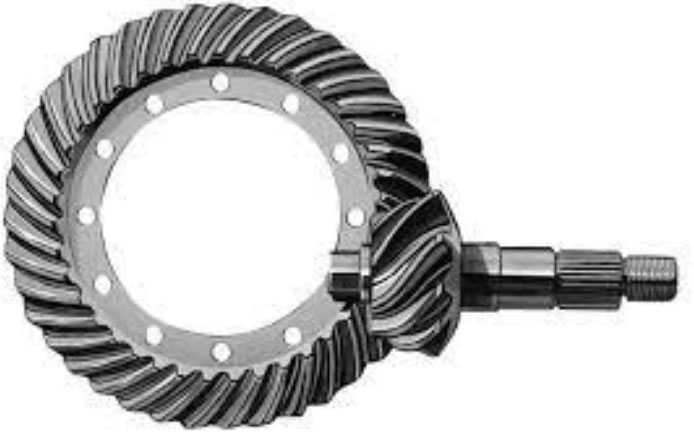Designing hypoid gears requires careful consideration of various engineering principles to ensure their functionality and performance. Let’s explore the key design principles of hypoid gears from an engineering perspective:

- Gear Geometry: The geometry of hypoid gears is defined by parameters such as the gear tooth profile, pitch diameter, helix angle, and offset. The tooth profile should be designed to ensure proper engagement and minimize stress concentrations. The pitch diameter determines the gear ratio and the speed reduction achieved. The helix angle, typically greater than zero, allows the sliding motion and torque transmission. The offset, which represents the displacement between the gear axes, affects the contact pattern and load distribution.
- Gear Tooth Profile: The tooth profile of hypoid gears is typically generated using a mathematical model that considers factors like tooth thickness, tooth height, and curvature. The most commonly used tooth profile is the Gleason system, which ensures smooth gear engagement and optimal load distribution. The tooth profile should be carefully designed to ensure proper contact, minimize noise and vibration, and maximize load-carrying capacity.
- Load Distribution: Hypoid gears are subjected to significant loads, and proper load distribution is critical for their durability and performance. The offset design of hypoid gears provides a larger contact area, allowing for better load sharing between the gear teeth. The tooth profile and tooth surface modifications can be optimized to distribute the load more evenly and reduce localized stresses.
- Manufacturing Considerations: The manufacturing process for hypoid gears involves precision machining and specialized equipment. The design should consider the capabilities and limitations of the manufacturing process to ensure the feasibility of producing the desired gear geometry. Close collaboration between design engineers and manufacturing experts is essential to achieve the intended design and ensure manufacturability.
- Lubrication and Cooling: Proper lubrication is crucial for the operation and longevity of hypoid gears. The design should consider effective lubrication and cooling mechanisms to minimize friction, reduce wear, and dissipate heat generated during operation. Adequate lubricant selection, oil flow, and cooling channels should be incorporated into the gear design.
- Stress Analysis: Hypoid gears experience complex loading conditions due to the offset design and sliding motion. It is important to perform stress analysis using computer-aided engineering (CAE) tools to evaluate the stress distribution, identify potential areas of high stress, and optimize the gear design accordingly. Finite element analysis (FEA) can help in assessing the structural integrity and predicting the gear’s performance under various operating conditions.
- Noise and Vibration Control: Hypoid gears can generate noise and vibration due to the sliding motion and high contact forces. Design considerations such as tooth profile modifications, gear surface finish, and gear housing stiffness can help in reducing noise and vibration levels. Analytical and experimental techniques, such as dynamic simulation and noise testing, can be employed to optimize the gear design for quieter operation.
- Material Selection: The selection of materials for hypoid gears is critical to ensure their strength, durability, and resistance to wear and fatigue. Factors such as load capacity, operating conditions, and cost need to be considered when choosing suitable gear materials. Common materials used for hypoid gears include alloy steels, such as 8620 or 9310, which offer a balance of strength and toughness.
- Quality Control: Strict quality control measures should be implemented throughout the manufacturing process to ensure the dimensional accuracy, surface finish, and gear performance. Proper inspection techniques, such as coordinate measuring machines (CMMs), gear analyzers, and gear testers, can be employed to verify the gear geometry, tooth contact pattern, and other critical parameters.
By considering these design principles, engineers can develop hypoid gears that meet the specific requirements of the application, including torque capacity, efficiency, noise levels, and reliability. Collaboration with experienced gear manufacturers and utilizing advanced design and analysis tools can greatly facilitate the design process and ensure optimal performance of hypoid gears in real-world applications.
